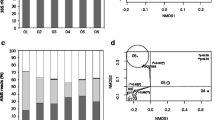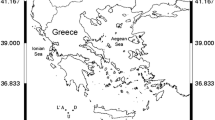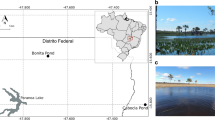Abstract
In this work, we analyzed the community structure and metabolic potential of sediment microbial communities in high-latitude coastal environments subjected to low to moderate levels of chronic pollution. Subtidal sediments from four low-energy inlets located in polar and subpolar regions from both Hemispheres were analyzed using large-scale 16S rRNA gene and metagenomic sequencing. Communities showed high diversity (Shannon’s index 6.8 to 10.2), with distinct phylogenetic structures (<40% shared taxa at the Phylum level among regions) but similar metabolic potential in terms of sequences assigned to KOs. Environmental factors (mainly salinity, temperature, and in less extent organic pollution) were drivers of both phylogenetic and functional traits. Bacterial taxa correlating with hydrocarbon pollution included families of anaerobic or facultative anaerobic lifestyle, such as Desulfuromonadaceae, Geobacteraceae, and Rhodocyclaceae. In accordance, biomarker genes for anaerobic hydrocarbon degradation (bamA, ebdA, bcrA, and bssA) were prevalent, only outnumbered by alkB, and their sequences were taxonomically binned to the same bacterial groups. BssA-assigned metagenomic sequences showed an extremely wide diversity distributed all along the phylogeny known for this gene, including bssA sensu stricto, nmsA, assA, and other clusters from poorly or not yet described variants. This work increases our understanding of microbial community patterns in cold coastal sediments, and highlights the relevance of anaerobic hydrocarbon degradation processes in subtidal environments.








Similar content being viewed by others
References
Doney SC, Ruckelshaus M, Emmett Duffy J, Barry JP, Chan F, English CA, et al. (2012) Climate change impacts on marine ecosystems Annu. Rev. Mar. Sci. 4:11–37
Atlas RM (2010) Microbial bioremediation in polar environments: current status and future directions. In: Bej AK, Aislabie J, Atlas RM (eds) Polar microbiology: the ecology, biodiversity and bioremediation potential of microorganisms in extremely cold environments. CRC Press, Boca Raton, pp. 373–391
Ghiglione J-F, Galand PE, Pommier T, Pedrós-Alió C, Maas EW, Bakker K, et al. (2012) Pole-to-pole biogeography of surface and deep marine bacterial communities Proc. Natl. Acad. Sci. 109:17633–17638
Hanson CA, Fuhrman JA, Horner-Devine MC, Martiny JBH (2012) Beyond biogeographic patterns: processes shaping the microbial landscape Nat. Rev. Microbiol. 10:497–506
Sul WJ, Oliver TA, Ducklow HW, Amaral-Zettler LA, Sogin ML (2013) Marine bacteria exhibit a bipolar distribution Proc. Natl. Acad. Sci. 110:2342–2347
Huettel M, Berg P, Kostka JE (2014) Benthic exchange and biogeochemical cycling in permeable sediments Annu. Rev. Mar. Sci. 6:23–51
Commendatore MG, Nievas ML, Amin O, Esteves JL (2012) Sources and distribution of aliphatic and polyaromatic hydrocarbons in coastal sediments from the Ushuaia Bay (Tierra del Fuego, Patagonia, Argentina) Mar. Environ. Res. 74:20–31
León VM, García I, Martínez-Gómez C, Campillo JA, Benedicto J (2014) Heterogeneous distribution of polycyclic aromatic hydrocarbons in surface sediments and red mullet along the Spanish Mediterranean coast Mar. Pollut. Bull. 87:352–363
Cravo-Laureau C, Duran R (2014) Marine coastal sediments microbial hydrocarbon degradation processes: contribution of experimental ecology in the omics’era Front. Microbiol. 5:39
Reese BK, Witmer AD, Moller S, Morse JW, Mills HJ (2013) Molecular assays advance understanding of sulfate reduction despite cryptic cycles Biogeochemistry 118:307–319
Acosta-González A, Marqués S (2016) Bacterial diversity in oil-polluted marine coastal sediments Energy Biotechnol. Environ. Biotechnol 38:24–32
Acosta-González A, Rosselló-Móra R, Marqués S (2013a) Characterization of the anaerobic microbial community in oil-polluted subtidal sediments: aromatic biodegradation potential after the prestige oil spill Environ. Microbiol. 15:77–92
Meckenstock RU, Mouttaki H (2011) Anaerobic degradation of non-substituted aromatic hydrocarbons Curr. Opin. Biotechnol. 22:406–414
Kappell AD, Wei Y, Newton RJ, Van Nostrand JD, Zhou J, McLellan SL, Hristova KR (2014) The polycyclic aromatic hydrocarbon degradation potential of Gulf of Mexico native coastal microbial communities after the Deepwater Horizon oil spill Front. Microbiol. 5:205
Kostka JE, Prakash O, Overholt WA, Green SJ, Freyer G, Canion A, et al. (2011) Hydrocarbon-degrading bacteria and the bacterial community response in Gulf of Mexico beach sands impacted by the Deepwater Horizon oil spill Appl. Environ. Microbiol. 77:7962–7974
Lamendella R, Strutt S, Borglin S, Chakraborty R, Tas N, Mason OU, et al. (2014) Assessment of the deepwater horizon oil spill impact on Gulf Coast microbial communities Front. Microbiol. 5:130
Mason OU, Scott NM, Gonzalez A, Robbins-Pianka A, Bælum J, Kimbrel J, et al. (2014) Metagenomics reveals sediment microbial community response to deepwater horizon oil spill ISME J. 8:1464–1475
Rodriguez-R LM, Overholt WA, Hagan C, Huettel M, Kostka JE, Konstantinidis KT (2015) Microbial community successional patterns in beach sands impacted by the deepwater horizon oil spill ISME J. 9:1928–1940
Scott NM, Hess M, Bouskill NJ, Mason OU, Jansson JK, Gilbert JA (2014) The microbial nitrogen cycling potential is impacted by polyaromatic hydrocarbon pollution of marine sediments Front. Microbiol. 5:108
Alonso-Gutiérrez J, Figueras A, Albaigés J, Jiménez N, Viñas M, Solanas AM, Novoa B (2009) Bacterial communities from shoreline environments (Costa da Morte, northwestern Spain) affected by the Prestige oil spill Appl. Environ. Microbiol. 75:3407–3418
Acosta-González A, Martirani-von Abercron S-M, Rosselló-Móra R, Wittich R-M, Marqués S (2015) The effect of oil spills on the bacterial diversity and catabolic function in coastal sediments: a case study on the Prestige oil spill Environ. Sci. Pollut. Res. 22:15200–15214
Kimes NE, Callaghan AV, Suflita JM, Morris PJ (2014) Microbial transformation of the Deepwater Horizon oil spill—past, present, and future perspectives Front. Microbiol. 5:603
Kostka JE, Teske AP, Joye SB, Head IM (2014) The metabolic pathways and environmental controls of hydrocarbon biodegradation in marine ecosystems Front. Microbiol. 5:471
Guibert L, Loviso C, Marcos M, Commendatore M, Dionisi H, Lozada M (2012) Alkane biodegradation genes from chronically-polluted subantarctic coastal sediments and their shifts in response to oil exposure Microb. Ecol. 64:605–616
Guibert LM, Loviso CL, Borglin S, Jansson JK, Dionisi HM, Lozada M (2015) Diverse bacterial groups contribute to the alkane degradation potential of chronically polluted subantarctic coastal sediments Microb. Ecol. 71:100–112
Marcos MS, Lozada M, Di Marzio WD, Dionisi HM (2012) Abundance, dynamics, and biogeographic distribution of seven polycyclic aromatic hydrocarbon dioxygenase gene variants in coastal sediments of Patagonia Appl. Environ. Microbiol. 78:1589–1592
Paisse S, Coulon F, Goñi-Urriza M, Peperzak L, McGenity TJ, Duran R (2008) Structure of bacterial communities along a hydrocarbon contamination gradient in a coastal sediment FEMS Microbiol. Ecol. 66:295–305
Paisse S, Duran R, Coulon F, Goñi-Urriza M (2011) Are alkane hydroxylase genes (alkB) relevant to assess petroleum bioremediation processes in chronically polluted coastal sediments? Appl. Microbiol. Biotechnol. 92:835–844
Paissé S, Goñi-Urriza M, Stadler T, Budzinski H, Duran R (2012) Ring-hydroxylating dioxygenase (RHD) expression in a microbial community during the early response to oil pollution FEMS Microbiol. Ecol. 80:77–86
Bargiela R, Mapelli F, Rojo D, Chouaia B, Tornés J, Borin S, et al. (2015) Bacterial population and biodegradation potential in chronically crude oil-contaminated marine sediments are strongly linked to temperature Sci Rep 5:11651
Mackelprang R, Waldrop MP, DeAngelis KM, David MM, Chavarria KL, Blazewicz SJ, et al. (2011) Metagenomic analysis of a permafrost microbial community reveals a rapid response to thaw Nature 480:368–371
Gilbert JA, Jansson JK, Knight R (2014) The Earth Microbiome project: successes and aspirations BMC Biol. 12:69
Caporaso JG, Kuczynski J, Stombaugh J, Bittinger K, Bushman FD, Costello EK, et al. (2010) QIIME allows analysis of high-throughput community sequencing data Nat. Methods 7:335–336
DeSantis TZ, Hugenholtz P, Larsen N, Rojas M, Brodie EL, Keller K, et al. (2006) Greengenes, a chimera-checked 16S rRNA gene database and workbench compatible with ARB Appl. Environ. Microbiol. 72:5069–5072
Matos MN, Lozada M, Anselmino LE, Musumeci MA, Henrissat B, Jansson JK, et al. (2016) Metagenomics unveils the attributes of the alginolytic guilds of sediments from four distant cold coastal environments Environ. Microbiol. 18:4471–4484
Markowitz VM, Chen I-MA, Chu K, Szeto E, Palaniappan K, Pillay M, et al. (2014) IMG/M 4 version of the integrated metagenome comparative analysis system Nucleic Acids Res. 42:D568–D573
Kanehisa M, Goto S (2000) KEGG: Kyoto encyclopedia of genes and genomes Nucleic Acids Res. 28:27–30
Parks DH, Beiko RG (2010) Identifying biologically relevant differences between metagenomic communities Bioinformatics 26:715–721
Legendre P, Legendre LFJ (2012) Numerical ecology. Elsevier
Kuntze K, Shinoda Y, Moutakki H, McInerney MJ, Vogt C, Richnow H-H, Boll M (2008) 6-Oxocyclohex-1-ene-1-carbonyl-coenzyme a hydrolases from obligately anaerobic bacteria: characterization and identification of its gene as a functional marker for aromatic compounds degrading anaerobes Environ. Microbiol. 10:1547–1556
Huson DH, Mitra S, Ruscheweyh H-J, Weber N, Schuster SC (2011) Integrative analysis of environmental sequences using MEGAN4 Genome Res. 21:1552–1560
Nie Y, Chi C-Q, Fang H, et al. (2014) Diverse alkane hydroxylase genes in microorganisms and environments Sci Rep 4:4968
Acosta-González A, Rosselló-Móra R, Marqués S (2013b) Diversity of benzylsuccinate synthase-like (bssA) genes in hydrocarbon-polluted marine sediments suggests substrate-dependent clustering Appl. Environ. Microbiol. 79:3667–3676
Berger SA, Krompass D, Stamatakis A (2011) Performance, accuracy, and web server for evolutionary placement of short sequence reads under maximum likelihood Syst. Biol. 60:291–302
Holte B, Dahle S, Gulliksen B, Næs K (1996) Some macrofaunal effects of local pollution and glacier-induced sedimentation, with indicative chemical analyses, in the sediments of two Arctic fjords Polar Biol. 16:549–557
Reimann S, Kallenborn R, Schmidbauer N (2009) Severe aromatic hydrocarbon pollution in the arctic town of Longyearbyen (Svalbard) caused by snowmobile emissions Env. Sci. Technol. 43:4791–4795
Dauner ALL, Hernández EA, MacCormack WP, Martins CC (2015) Molecular characterisation of anthropogenic sources of sedimentary organic matter from Potter Cove, King George Island, Antarctica Sci. Total Environ. 502:408–416
Korpinen S, Meski L, Andersen JH, Laamanen M (2012) Human pressures and their potential impact on the Baltic Sea ecosystem Ecol. Indic. 15:105–114
McLachlan A, Brown AC (2006) 14—Human impacts.The ecology of sandy shores, Second edn. Academic Press, Burlington, pp. 273–301
Rideout JR, He Y, Navas-Molina JA, Walters WA, Ursell LK, Gibbons SM, et al. (2014) Subsampled open-reference clustering creates consistent, comprehensive OTU definitions and scales to billions of sequences Peer J 2:e545
Wang Y, Sheng H-F, He Y, Wu J-Y, Jiang Y-X, Tam NF-Y, Zhou H-W (2012) Comparison of the levels of bacterial diversity in freshwater, intertidal wetland, and marine sediments by using millions of Illumina tags Appl. Environ. Microbiol. 78:8264–8271
Webster G, O’Sullivan LA, Meng Y, Williams AS, Sass AM, Watkins AJ, et al. (2015) Archaeal community diversity and abundance changes along a natural salinity gradient in estuarine sediments FEMS Microbiol. Ecol. 91:1–18
Purdy KJ, Nedwell DB, Embley TM (2003) Analysis of the sulfate-reducing bacterial and methanogenic archaeal populations in contrasting Antarctic sediments Appl. Environ. Microbiol. 69:3181–3191
Caporaso JG, Lauber CL, Walters WA, Berg-Lyons D, Huntley J, Fierer N, et al. (2012) Ultra-high-throughput microbial community analysis on the Illumina HiSeq and MiSeq platforms ISME J. 6:1621–1624
Apprill A, McNally S, Parsons R, Weber L (2015) Minor revision to V4 region SSU rRNA 806R gene primer greatly increases detection of SAR11 bacterioplankton Aquat. Microb. Ecol. 75:129–137
Peter H, Beier S, Bertilsson S, Lindstrom ES, Langenheder S, Tranvik LJ (2011) Function-specific response to depletion of microbial diversity ISME J 5:351–361
Shade A, Peter H, Allison SD, Baho DL, Berga M, Bürgmann H, et al. (2012) Fundamentals of microbial community resistance and resilience Front. Microbiol. 3:417
Campbell BJ, Kirchman DL (2013) Bacterial diversity, community structure and potential growth rates along an estuarine salinity gradient ISME J. 7:210–220
Nobu MK, Dodsworth JA, Murugapiran SK, Rinke C, Gies EA, Webster G, et al. (2016) Phylogeny and physiology of candidate phylum “Atribacteria” (OP9/JS1) inferred from cultivation-independent genomics ISME J. 10:273–286
Youssef NH, Farag IF, Rinke C, Hallam SJ, Woyke T, Elshahed MS (2015) In silico analysis of the metabolic potential and niche specialization of candidate phylum “Latescibacteria” (ws3) PLOS ONE 10:e0127499
Gibbons SM, Caporaso JG, Pirrung M, Field D, Knight R, Gilbert JA (2013) Evidence for a persistent microbial seed bank throughout the global ocean Proc. Natl. Acad. Sci. 110:4651–4655
Zinger L, Boetius A, Ramette A (2014) Bacterial taxa–area and distance–decay relationships in marine environments Mol. Ecol. 23:954–964
Buttigieg PL, Ramette A (2014) A guide to statistical analysis in microbial ecology: a community-focused, living review of multivariate data analyses FEMS Microbiol. Ecol. 90:543–550
Ivanova EP, Flavier S, Christen R (2004) Phylogenetic relationships among marine Alteromonas-like proteobacteria: emended description of the family Alteromonadaceae and proposal of Pseudoalteromonadaceae fam. nov., Colwelliaceae fam. nov., Shewanellaceae fam. nov., Moritellaceae fam. nov., Ferrimonadaceae fam. nov., Idiomarinaceae fam. nov. and Psychromonadaceae fam. nov Int. J. Syst. Evol. Microbiol. 54:1773–1788
Methé BA, Nelson KE, Deming JW, Momen B, Melamud E, Zhang X, et al. (2005) The psychrophilic lifestyle as revealed by the genome sequence of Colwellia psychrerythraea 34H through genomic and proteomic analyses Proc. Natl. Acad. Sci. U. S. A. 102:10913–10918
Riley M, Staley JT, Danchin A, Wang TZ, Brettin TS, Hauser LJ, et al. (2008) Genomics of an extreme psychrophile, Psychromonas ingrahamii BMC Genomics 9:210
Dupont CL, Larsson J, Yooseph S, Ininbergs K, Goll J, Asplund-Samuelsson J, et al. (2014) Functional tradeoffs underpin salinity-driven divergence in microbial community composition PLoS One 9:e89549
Thureborn P, Lundin D, Plathan J, Poole AM, Sjöberg B-M, Sjöling S (2013) A metagenomics transect into the deepest point of the Baltic Sea reveals clear stratification of microbial functional capacities PLoS One 8:e74983
Oren A (2014) The family Rhodocyclaceae. In: Rosenberg E, DeLong EF, Lory S, Stackebrandt E, Thompson F (eds) The prokaryotes. Springer, Berlin, pp. 975–998
Muegge BD, Kuczynski J, Knights D, Clemente JC, González A, Fontana L, et al. (2011) Diet drives convergence in gut microbiome functions across mammalian phylogeny and within humans Science 332:970–974
Raes J, Letunic I, Yamada T, Jensen LJ, Bork P (2011) Toward molecular trait-based ecology through integration of biogeochemical, geographical and metagenomic data Mol. Syst. Biol. 7:473
Gianoulis TA, Raes J, Patel PV, Bjornson R, Korbel JO, Letunic I, et al. (2009) Quantifying environmental adaptation of metabolic pathways in metagenomics Proc. Natl. Acad. Sci. 106:1374–1379
Lozupone CA, Knight R (2007) Global patterns in bacterial diversity Proc Natl Acad Sci U S A 104:11436–11440
Sunagawa S, Coelho LP, Chaffron S, Kultima JR, Labadie K, Salazar G, et al. (2015) Structure and function of the global ocean microbiome Science 348:1261359
Hernández EA, Piquet AM-T, Lopez JL, Buma AGJ, Cormack WPM (2014) Marine archaeal community structure from Potter Cove, Antarctica: high temporal and spatial dominance of the phylum Thaumarchaeota Polar Biol. 38:117–130
Conley DJ, Björck S, Bonsdorff E, Carstensen J, Destouni G, Gustafsson BG, et al. (2009) Hypoxia-related processes in the Baltic Sea Environ. Sci. Technol. 43:3412–3420
Gil MN, Torres AI, Amin O, Esteves JL (2011) Assessment of recent sediment influence in an urban polluted subantarctic coastal ecosystem. Beagle Channel (southern Argentina) Mar. Pollut. Bull. 62:201–207
Estelmann S, Blank I, Feldmann A, Boll M (2015) Two distinct old yellow enzymes are involved in naphthyl ring reduction during anaerobic naphthalene degradation Mol. Microbiol. 95:162–172
Loviso C l, Lozada M, Guibert L m, Musumeci M a, Sarango Cardenas S, Kuin RV, et al. (2015) Metagenomics reveals the high polycyclic aromatic hydrocarbon-degradation potential of abundant uncultured bacteria from chronically polluted subantarctic and temperate coastal marine environments J. Appl. Microbiol. 119:411–424
Wöhlbrand L, Jacob JH, Kube M, Mussmann M, Jarling R, Beck A, et al. (2013) Complete genome, catabolic sub-proteomes and key-metabolites of Desulfobacula toluolica Tol2, a marine, aromatic compound-degrading, sulfate-reducing bacterium Environ. Microbiol. 15:1334–1355
Kniemeyer O, Musat F, Sievert SM, Knittel K, Wilkes H, Blumenberg M, et al. (2007) Anaerobic oxidation of short-chain hydrocarbons by marine sulphate-reducing bacteria Nature 449:898–901
Jaekel U, Musat N, Adam B, Kuypers M, Grundmann O, Musat F (2013) Anaerobic degradation of propane and butane by sulfate-reducing bacteria enriched from marine hydrocarbon cold seeps ISME J. 7:885–895
Kleindienst S, Herbst F-A, Stagars M, von Netzer F, von Bergen M, Seifert J, et al. (2014) Diverse sulfate-reducing bacteria of the Desulfosarcina/Desulfococcus clade are the key alkane degraders at marine seeps ISME J. 8:2029–2044
Musat F (2015) The anaerobic degradation of gaseous, nonmethane alkanes—from in situ processes to microorganisms Comput. Struct. Biotechnol. J. 13:222–228
Beasley KK, Nanny MA (2012) Potential energy surface for anaerobic oxidation of methane via fumarate addition Environ. Sci. Technol. 46:8244–8252
Callaghan AV (2013) Enzymes involved in the anaerobic oxidation of n-alkanes: from methane to long-chain paraffins Front. Microbiol. 4:89
Mueller TJ, Grisewood MJ, Nazem-Bokaee H, Gopalakrishnan S, Ferry JG, Wood TK, Maranas CD (2015) Methane oxidation by anaerobic archaea for conversion to liquid fuels J. Ind. Microbiol. Biotechnol. 42:391–401
von Netzer F, Kuntze K, Vogt C, Richnow HH, Boll M, Lueders T (2016) Functional gene markers for fumarate-adding and dearomatizing key enzymes in anaerobic aromatic hydrocarbon degradation in terrestrial environments J. Mol. Microbiol. Biotechnol. 26:180–194
Rabus R, Boll M, Heider J, Meckenstock RU, Buckel W, Einsle O, et al. (2016) Anaerobic microbial degradation of hydrocarbons: from enzymatic reactions to the environment J. Mol. Microbiol. Biotechnol. 26:5–28
Acknowledgments
M.L. and H.M.D. are staff members from The Argentinean National Research Council (CONICET), and F.E. is a doctoral fellow from CONICET. The amplicon dataset was generated by the Earth Microbiome Project (www.earthmicrobiome.org/). The metagenomic dataset was generated at the Department of Energy-Joint Genome Institute (DOE-JGI) under the Community Sequencing Program (CSP proposal ID 328, project IDs 403959, 404206, 404777–404782, 404786, 404788–404801). Sampling was funded by grants from CONICET (No. 112-200801-01736) and The National Agency for the Promotion of Science and Technology of Argentina (ANPCyT PICT2008 No. 0468), the Argentinean Antarctic Institute, the Universidad de Buenos Aires (UBA 20020100100378), ANPCyT (PICT-O 0124), and the Research Council of Norway (grant no. 228107). This research was also partly funded under the Laboratory Directed Research and Development Program at PNNL, a multi-program national laboratory operated by Battelle for the U.S. Department of Energy under Contract DE-AC05-76RL01830. We would like to thank Ricardo Vera, Horacio Ocariz, and Alejandro Ulrich for their help in sample collection.
Author information
Authors and Affiliations
Corresponding author
Ethics declarations
Conflict of Interest
The authors declare no conflict of interest.
Electronic supplementary material
ESM 1
(PDF 18611 kb)
Rights and permissions
About this article
Cite this article
Espínola, F., Dionisi, H.M., Borglin, S. et al. Metagenomic Analysis of Subtidal Sediments from Polar and Subpolar Coastal Environments Highlights the Relevance of Anaerobic Hydrocarbon Degradation Processes. Microb Ecol 75, 123–139 (2018). https://doi.org/10.1007/s00248-017-1028-5
Received:
Accepted:
Published:
Issue Date:
DOI: https://doi.org/10.1007/s00248-017-1028-5




